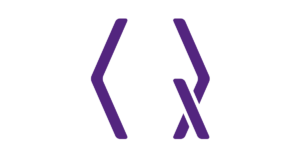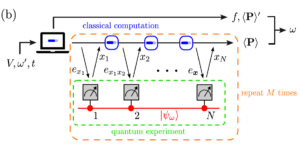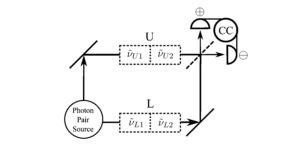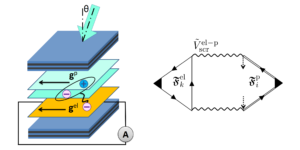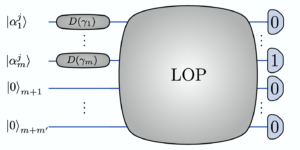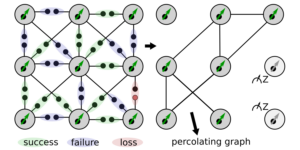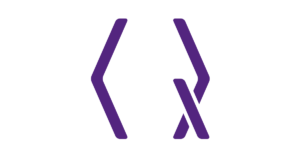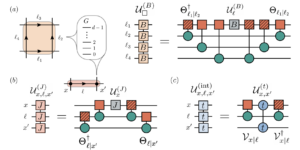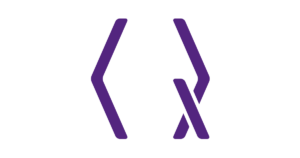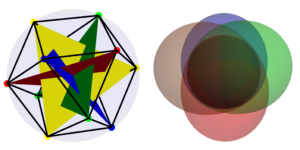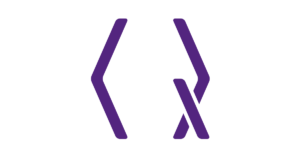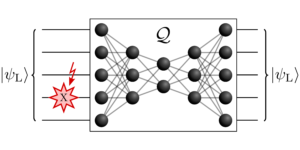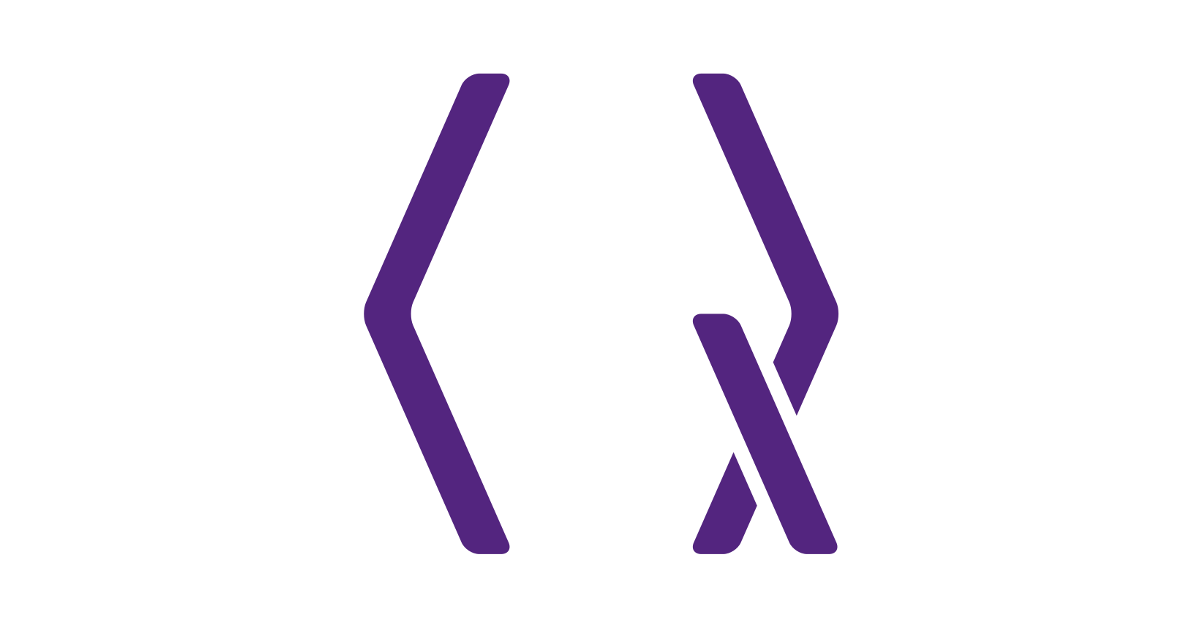
1NEST, Scuola Normale Superiore und Istituto Nanoscienze-CNR, I-56126 Pisa, Italien
2Elektrotechnik und Informationstechnik, University of Illinois Urbana-Champaign, Urbana, Illinois, 61801, USA
Findest du dieses Paper interessant oder möchtest du darüber diskutieren? Scite oder hinterlasse einen Kommentar zu SciRate.
Abstrakt
Wir führen einen neuen Satz von Quantenkanälen ein: resonante Multilevel-Amplituden-Dämpfungskanäle (ReMAD). Sie können unter anderem Energiedissipationseffekte in mehrstufigen Atomsystemen beschreiben, die durch die Wechselwirkung mit einer bosonischen Umgebung bei Nulltemperatur hervorgerufen werden. Im Gegensatz zur bereits bekannten Klasse der Multilevel-Amplituden-Dämpfungskanäle (MAD) ermöglicht diese neue Kartenklasse das Vorhandensein einer Umgebung, die nicht in der Lage ist, Übergänge mit identischen Energielücken zu unterscheiden. Nachdem wir die Algebra ihrer Zusammensetzungsregeln charakterisiert haben, zeigen wir durch Analyse des Qutrit-Falls, dass dieser neue Satz von Kanälen in weiten Bereichen des zulässigen Parameterraums Abbaubarkeit und Antiabbaubarkeit aufweisen kann. Dort berechnen wir ihre Quantenkapazität und ihre private klassische Kapazität. Wir zeigen, dass diese Kapazitäten auch in Regionen des Parameterraums exakt berechnet werden können, in denen die Kanäle weder abbaubar noch antiabbaubar sind.
► BibTeX-Daten
► Referenzen
[1] D. Cozzolino, B. Da Lio, D. Bacco und LK Oxenløwe, Advanced Quantum Technologies 2, 1900038 (2019), URL https://doi.org/10.1002/qute.201900038.
https: / / doi.org/ 10.1002 / qute.201900038
[2] Y. Wang, Z. Hu, BC Sanders und S. Kais, Frontiers in Physics 8, 479 (2020), ISSN 2296-424X, URL https:///doi.org/10.3389/fphy.2020.589504.
https: / / doi.org/ 10.3389 / fphy.2020.589504
[3] A. Hill, Beyond qubits: Unlocking the Third State in Quantum Processors (2021), URL https:///medium.com/rigetti/beyond-qubits-unlocking-the-third-state-in-quantum-processors -12d2f84133c4.
https:///medium.com/rigetti/beyond-qubits-unlocking-the-third-state-in-quantum-processors-12d2f84133c4
[4] M. Fanizza, F. Kianvash und V. Giovannetti, Phys. Rev. Lett. 125, 020503 (2020), URL https:///doi.org/10.1103/PhysRevLett.125.020503.
https://doi.org/ 10.1103/PhysRevLett.125.020503
[5] F. Kianvash, M. Fanizza und V. Giovannetti, Quantum 6, 647 (2022), ISSN 2521-327X, URL https:///doi.org/10.22331/q-2022-02-09-647 .
https://doi.org/10.22331/q-2022-02-09-647
[6] I. Devetak und PW Shor, Communications in Mathematical Physics 256, 287 (2005), URL https://doi.org/10.1007/s00220-005-1317-6.
https://doi.org/10.1007/s00220-005-1317-6
[7] A. D'Arrigo, G. Benenti und G. Falci, New Journal of Physics 9, 310 (2007), URL https://doi.org/10.1088/1367-2630/9/9 /310.
https://doi.org/10.1088/1367-2630/9/9/310
[8] S. Chessa und V. Giovannetti, Communications Physics 4, 22 (2021a), ISSN 2399-3650, URL https:///doi.org/10.1038/s42005-021-00524-4.
https://doi.org/10.1038/s42005-021-00524-4
[9] S. Chessa und V. Giovannetti, Quantum 5, 504 (2021b), ISSN 2521-327X, URL https:///doi.org/10.22331/q-2021-07-15-504.
https://doi.org/10.22331/q-2021-07-15-504
[10] F. Leditzky, D. Leung, V. Siddhu, G. Smith und J. Smolin, The platypus of the Quantum Channel Zoo (2022), arXiv:2202.08380, URL https://doi.org/10.48550/ arXiv.2202.08380.
https:///doi.org/10.48550/arXiv.2202.08380
arXiv: 2202.08380
[11] TS Cubitt, MB Ruskai und G. Smith, Journal of Mathematical Physics 49, 102104 (2008), URL https:///doi.org/10.1063/1.2953685.
https: / / doi.org/ 10.1063 / 1.2953685
[12] S. Singh und N. Datta, npj Quantum Information 8, 50 (2022), ISSN 2056-6387, URL https:///doi.org/10.1038/s41534-022-00550-2.
https://doi.org/10.1038/s41534-022-00550-2
[13] AS Holevo, Quantum Systems, Channels, Information (De Gruyter, 2019), URL https://doi.org/10.1515/9783110642490.
https: / / doi.org/ 10.1515 / 9783110642490
[14] MM Wilde, Quantum Information Theory (Cambridge University Press, Cambridge, 2017), 2. Aufl., ISBN 9781107176164, URL https://doi.org/10.1017/9781316809976.
https: / / doi.org/ 10.1017 / 9781316809976
[15] J. Watrous, The Theory of Quantum Information (Cambridge University Press, Cambridge, 2018), ISBN 9781107180567, URL https:///doi.org/10.1017/9781316848142.
https: / / doi.org/ 10.1017 / 9781316848142
[16] M. Hayashi, Quantum Information Theory (Springer, 2017), 2. Auflage, ISBN 9783662497234, URL https:///doi.org/10.1007/978-3-662-49725-8.
https://doi.org/10.1007/978-3-662-49725-8
[17] MA Nielsen und IL Chuang, Quantum Computation and Quantum Information: 10th Anniversary Edition (Cambridge University Press, Cambridge, 2010), ISBN 9781107002173, URL https://doi.org/10.1017/CBO9780511976667.
https: / / doi.org/ 10.1017 / CBO9780511976667
[18] S. Imre und L. Gyongyosi, Advanced Quantum Communications: An Engineering Approach (Wiley-IEEE Press, 2012), 1. Auflage, ISBN 1118002369, URL https:///doi.org/10.1002/9781118337462.
https: / / doi.org/ 10.1002 / 9781118337462
[19] AS Holevo und V. Giovannetti, Reports on Progress in Physics 75, 046001 (2012), URL https://doi.org/10.1088/0034-4885/75/4/046001.
https://doi.org/10.1088/0034-4885/75/4/046001
[20] L. Gyongyosi, S. Imre und HV Nguyen, IEEE Communications Surveys Tutorials 20, 1149 (2018), URL https://doi.org/10.1109/COMST.2017.2786748.
https:///doi.org/10.1109/COMST.2017.2786748
[21] Y. Huang, New Journal of Physics 16, 033027 (2014), URL https:///doi.org/10.1088/1367-2630/16/3/033027.
https://doi.org/10.1088/1367-2630/16/3/033027
[22] T. Cubitt, D. Elkouss, W. Matthews, M. Ozols, D. Pérez-García und S. Strelchuk, Nature Communications 6, 6739 (2015), ISSN 2041-1723, URL https://doi. org/10.1038/ncomms7739.
https: / / doi.org/ 10.1038 / ncomms7739
[23] D. Elkouss und D. Pérez-García, Nature Communications 9, 1149 (2018), ISSN 2041-1723, URL https://doi.org/10.1038/s41467-018-03428-0.
https://doi.org/10.1038/s41467-018-03428-0
[24] MB Hastings, Nature Physics 5, 255 (2009), ISSN 1745-2481, URL https://doi.org/10.1038/nphys1224.
https: / / doi.org/ 10.1038 / nphys1224
[25] G. Smith und J. Yard, Science 321, 1812 (2008), URL https:///doi.org/10.1126/science.1162242.
https: / / doi.org/ 10.1126 / science.1162242
[26] K. Li, A. Winter, X. Zou und G. Guo, Phys. Rev. Lett. 103, 120501 (2009), URL https:///doi.org/10.1103/PhysRevLett.103.120501.
https://doi.org/ 10.1103/PhysRevLett.103.120501
[27] EY Zhu, Q. Zhuang, M.-H. Hsieh und PW Shor, IEEE Transactions on Information Theory 65, 3973 (2019), URL https:///doi.org/10.1109/TIT.2018.2889082.
https: / / doi.org/ 10.1109 / TIT.2018.2889082
[28] EY Zhu, Q. Zhuang und PW Shor, Phys. Rev. Lett. 119, 040503 (2017), URL https:///doi.org/10.1103/PhysRevLett.119.040503.
https://doi.org/ 10.1103/PhysRevLett.119.040503
[29] F. Caruso und V. Giovannetti, Phys. Rev. A 74, 062307 (2006), URL https://doi.org/10.1103/PhysRevA.74.062307.
https: / / doi.org/ 10.1103 / PhysRevA.74.062307
[30] G. Smith und JA Smolin, in 2008 IEEE Information Theory Workshop (2008), S. 368–372, URL https://doi.org/10.1109/ITW.2008.4578688.
https: / / doi.org/ 10.1109 / ITW.2008.4578688
[31] K. Brádler, N. Dutil, P. Hayden und A. Muhammad, Journal of Mathematical Physics 51, 072201 (2010), URL https://doi.org/10.1063/1.3449555.
https: / / doi.org/ 10.1063 / 1.3449555
[32] S. Watanabe, Phys. Rev. A 85, 012326 (2012), URL https:///doi.org/10.1103/PhysRevA.85.012326.
https: / / doi.org/ 10.1103 / PhysRevA.85.012326
[33] L. Gyongyosi, IEEE Access 2, 333 (2014), URL https:///doi.org/10.1109/ACCESS.2014.2317652.
https: / / doi.org/ 10.1109 / ACCESS.2014.2317652
[34] D. Sutter, VB Scholz, A. Winter und R. Renner, IEEE Transactions on Information Theory 63, 7832 (2017), URL https:///doi.org/10.1109/TIT.2017.2754268.
https: / / doi.org/ 10.1109 / TIT.2017.2754268
[35] S. Pirandola, R. Laurenza, C. Ottaviani und L. Banchi, Nature Communications 8, 15043 (2017), ISSN 2041-1723, URL https:///doi.org/10.1038/ncomms15043.
https: / / doi.org/ 10.1038 / ncomms15043
[36] A. Anshu, in 2017 IEEE Information Theory Workshop (ITW) (2017), S. 214–218, URL https://doi.org/10.1109/ITW.2017.8277947.
https: / / doi.org/ 10.1109 / ITW.2017.8277947
[37] F. Leditzky, D. Leung und G. Smith, Phys. Rev. Lett. 120, 160503 (2018), URL https://doi.org/10.1103/PhysRevLett.120.160503.
https://doi.org/ 10.1103/PhysRevLett.120.160503
[38] M. Tomamichel, MM Wilde und A. Winter, IEEE Transactions on Information Theory 63, 715 (2017), URL https://doi.org/10.1109/TIT.2016.2615847.
https: / / doi.org/ 10.1109 / TIT.2016.2615847
[39] MM Wilde, M. Tomamichel und M. Berta, IEEE Transactions on Information Theory 63, 1792 (2017), URL https://doi.org/10.1109/TIT.2017.2648825.
https: / / doi.org/ 10.1109 / TIT.2017.2648825
[40] M. Christandl und A. Müller-Hermes, Communications in Mathematical Physics 353, 821 (2017), ISSN 1432-0916, URL https:///doi.org/10.1007/s00220-017-2885-y.
https: / / doi.org/ 10.1007 / s00220-017-2885-y
[41] X. Wang, K. Fang und R. Duan, IEEE Transactions on Information Theory 65, 2583 (2019), URL https://doi.org/10.1109/TIT.2018.2874031.
https: / / doi.org/ 10.1109 / TIT.2018.2874031
[42] C. Hirche, C. Rouzé und D. Stilck França, Quantum 6, 862 (2022), ISSN 2521-327X, URL https://doi.org/10.22331/q-2022-11-28- 862.
https://doi.org/10.22331/q-2022-11-28-862
[43] K. Fang und H. Fawzi, Communications in Mathematical Physics 384, 1615 (2021), ISSN 1432-0916, URL https://doi.org/10.1007/s00220-021-04064-4.
https://doi.org/10.1007/s00220-021-04064-4
[44] C. Hirche und F. Leditzky, Bounding Quantum Capacity via Partial Orders and Complementarity (2022), arXiv:2202.11688, URL https://doi.org/10.48550/arXiv.2202.11688.
https:///doi.org/10.48550/arXiv.2202.11688
arXiv: 2202.11688
[45] O. Fawzi, A. Shayeghi und H. Ta, im 2021 IEEE International Symposium on Information Theory (ISIT) (2021), S. 272–277, URL https:///doi.org/10.1109/ISIT45174.2021.9517913 .XNUMX.
https: / / doi.org/ 10.1109 / ISIT45174.2021.9517913
[46] K. Hammerer, AS Sørensen und ES Polzik, Rev. Mod. Physik. 82, 1041 (2010), URL https:///doi.org/10.1103/RevModPhys.82.1041.
https: / / doi.org/ 10.1103 / RevModPhys.82.1041
[47] N. Sangouard, C. Simon, H. de Riedmatten und N. Gisin, Rev. Mod. Physik. 83, 33 (2011), URL https:///doi.org/10.1103/RevModPhys.83.33.
https: / / doi.org/ 10.1103 / RevModPhys.83.33
[48] A. Reiserer und G. Rempe, Rev. Mod. Physik. 87, 1379 (2015), URL https:///doi.org/10.1103/RevModPhys.87.1379.
https: / / doi.org/ 10.1103 / RevModPhys.87.1379
[49] JN Damask, Polarisation optics in telecommunications (Springer Series in Optical Sciences, 2005), 1. Auflage, ISBN 978-0-387-26302-1, URL https:///doi.org/10.1007/b137386.
https: / / doi.org/ 10.1007 / b137386
[50] D. Gottesman, A. Kitaev und J. Preskill, Phys. Rev. A 64, 012310 (2001), URL https:///doi.org/10.1103/PhysRevA.64.012310.
https: / / doi.org/ 10.1103 / PhysRevA.64.012310
[51] SD Bartlett, H. de Guise und BC Sanders, Phys. Rev. A 65, 052316 (2002), URL https:///doi.org/10.1103/PhysRevA.65.052316.
https: / / doi.org/ 10.1103 / PhysRevA.65.052316
[52] BM Terhal, J. Conrad und C. Vuillot, Quantum Science and Technology 5, 043001 (2020), URL https://doi.org/10.1088/2058-9565/ab98a5.
https://doi.org/10.1088/2058-9565/ab98a5
[53] W. Cai, Y. Ma, W. Wang, C.-L. Zou und L. Sun, Fundamental Research 1, 50 (2021), ISSN 2667-3258, URL https:///doi.org/10.1016/j.fmre.2020.12.006.
https:///doi.org/10.1016/j.fmre.2020.12.006
[54] S. Carretta, D. Zueco, A. Chiesa, Á. Gómez-León und F. Luis, Applied Physics Letters 118, 240501 (2021), URL https://doi.org/10.1063/5.0053378.
https: / / doi.org/ 10.1063 / 5.0053378
[55] WF Stinespring, Proceedings of the American Mathematical Society 6, 211 (1955), URL https:///doi.org/10.2307/2032342.
https: / / doi.org/ 10.2307 / 2032342
[56] K. Kraus, Annals of Physics 64, 311 (1971), ISSN 0003-4916, URL https://doi.org/10.1016/0003-4916(71)90108-4.
https://doi.org/10.1016/0003-4916(71)90108-4
[57] Y. Ouyang, Quantum Information and Computation 14, 917 (2014), URL https:///doi.org/10.26421/QIC14.11-12-2.
https: / / doi.org/ 10.26421 / QIC14.11-12-2
[58] O. Fawzi, A. Müller-Hermes und A. Shayeghi, in der 13. Innovations in Theoretical Computer Science Conference (ITCS 2022), herausgegeben von M. Braverman (Schloss Dagstuhl – Leibniz-Zentrum für Informatik, Dagstuhl, Deutschland, 2022), Bd. 215 von Leibniz International Proceedings in Informatics (LIPIcs), S. 68:1–68:20, ISBN 978-3-95977-217-4, ISSN 1868-8969, URL https://doi.org/10.4230 /LIPics.ITCS.2022.68.
https: // doi.org/ 10.4230 / LIPIcs.ITCS.2022.68
[59] B. Schumacher und MA Nielsen, Phys. Rev. A 54, 2629 (1996), URL https:///doi.org/10.1103/PhysRevA.54.2629.
https: / / doi.org/ 10.1103 / PhysRevA.54.2629
[60] S. Lloyd, Phys. Rev. A 55, 1613 (1997), URL https:///doi.org/10.1103/PhysRevA.55.1613.
https: / / doi.org/ 10.1103 / PhysRevA.55.1613
[61] P. W. Shor, in Vorlesungsunterlagen, MSRI Workshop on Quantum Computation (Quantum Information and Cryptography) (2002), URL https://www.msri.org/workshops/203/schedules/1181.
https:///www.msri.org/workshops/203/schedules/1181
[62] I. Devetak, IEEE Transactions on Information Theory 51, 44 (2005), URL https:///doi.org/10.1109/TIT.2004.839515.
https: / / doi.org/ 10.1109 / TIT.2004.839515
[63] AS Holevo, Problemy Peredachi Informatsii 9, 3 (1973), URL http://www.mathnet.ru/eng/ppi903.
http:///www.mathnet.ru/eng/ppi903
[64] N. Cai, A. Winter und RW Yeung, Problems of Information Transmission 40, 318 (2004), URL https:///doi.org/10.1007/s11122-005-0002-x.
https: / / doi.org/ 10.1007 / s11122-005-0002-x
[65] MM Wolf und D. Perez-Garcia, Physical Review A 75, 012303 (2007), URL https:///doi.org/10.1103/PhysRevA.75.012303.
https: / / doi.org/ 10.1103 / PhysRevA.75.012303
[66] G. Smith und JA Smolin, Physical Review Letters 98, 030501 (2007), URL https:///doi.org/10.1103/PhysRevLett.98.030501.
https://doi.org/ 10.1103/PhysRevLett.98.030501
[67] G. Smith, Physical Review A 78, 022306 (2008), URL https:///doi.org/10.1103/PhysRevA.78.022306.
https: / / doi.org/ 10.1103 / PhysRevA.78.022306
[68] J. Yard, P. Hayden und I. Devetak, IEEE Transactions on Information Theory 54, 3091 (2008), URL https://doi.org/10.1109/TIT.2008.924665.
https: / / doi.org/ 10.1109 / TIT.2008.924665
[69] CH Bennett, DP DiVincenzo und JA Smolin, Phys. Rev. Lett. 78, 3217 (1997), URL https:///doi.org/10.1103/PhysRevLett.78.3217.
https://doi.org/ 10.1103/PhysRevLett.78.3217
[70] V. Giovannetti und R. Fazio, Phys. Rev. A 71, 032314 (2005), URL https://doi.org/10.1103/PhysRevA.71.032314.
https: / / doi.org/ 10.1103 / PhysRevA.71.032314
[71] K. Brádler, Open Systems & Information Dynamics 22, 1550026 (2015), URL https:///doi.org/10.1142/S1230161215500262.
https: / / doi.org/ 10.1142 / S1230161215500262
[72] CH Bennett, G. Brassard, C. Crépeau, R. Jozsa, A. Peres und WK Wootters, Phys. Rev. Lett. 70, 1895 (1993), URL https://doi.org/10.1103/PhysRevLett.70.1895.
https://doi.org/ 10.1103/PhysRevLett.70.1895
[73] CH Bennett und SJ Wiesner, Phys. Rev. Lett. 69, 2881 (1992), URL https://doi.org/10.1103/PhysRevLett.69.2881.
https://doi.org/ 10.1103/PhysRevLett.69.2881
[74] CH Bennett, PW Shor, JA Smolin und AV Thapliyal, Phys. Rev. Lett. 83, 3081 (1999), URL https://doi.org/10.1103/PhysRevLett.83.3081.
https://doi.org/ 10.1103/PhysRevLett.83.3081
[75] C. Bennett, P. Shor, J. Smolin und A. Thapliyal, IEEE Transactions on Information Theory 48, 2637 (2002), URL https:///doi.org/10.1109/TIT.2002.802612.
https: / / doi.org/ 10.1109 / TIT.2002.802612
Zitiert von
Konnte nicht abrufen Crossref zitiert von Daten während des letzten Versuchs 2023-01-19 14:14:17: Von Crossref konnten keine zitierten Daten für 10.22331 / q-2023-01-19-902 abgerufen werden. Dies ist normal, wenn der DOI kürzlich registriert wurde. Auf SAO / NASA ADS Es wurden keine Daten zum Zitieren von Werken gefunden (letzter Versuch 2023-01-19 14:14:18).
Dieses Papier ist in Quantum unter dem veröffentlicht Creative Commons Namensnennung 4.0 International (CC BY 4.0) Lizenz. Das Copyright verbleibt bei den ursprünglichen Copyright-Inhabern wie den Autoren oder deren Institutionen.
- SEO-gestützte Content- und PR-Distribution. Holen Sie sich noch heute Verstärkung.
- Platoblockkette. Web3-Metaverse-Intelligenz. Wissen verstärkt. Hier zugreifen.
- Quelle: https://quantum-journal.org/papers/q-2023-01-19-902/
- 1
- 10
- 11
- 1996
- 1999
- 2001
- 2011
- 2012
- 2014
- 2016
- 2017
- 2018
- 2019
- 2020
- 2021
- 2022
- 28
- 39
- 67
- 7
- 70
- 9
- 98
- a
- ABSTRACT
- Zugang
- advanced
- Zugehörigkeiten
- Nach der
- erlaubt
- bereits
- amerikanisch
- unter
- Analyse
- und
- Jubiläum
- angewandt
- Ansatz
- Autor
- Autoren
- Beyond
- Break
- Cambridge
- Kapazitäten
- Kapazität
- Häuser
- Kanal
- Kanäle
- Klasse
- Kommentar
- Unterhaus
- Kommunikation
- Berechnung
- Berechnen
- Computer
- Informationstechnik
- Computerwissenschaften
- Konferenz
- Urheberrecht
- könnte
- Geheimschrift
- technische Daten
- beschreiben
- diskutieren
- im
- Dynamik
- ed
- Ausgabe
- Effekten
- Energie
- Entwicklung
- Arbeitsumfeld
- genau
- zeigen
- gefunden
- für
- Frontiers
- fundamental
- Deutschland
- Harvard
- Inhaber
- HTTPS
- identisch
- IEEE
- Illinois
- in
- Information
- Innovationen
- Institutionen
- Interaktion
- interessant
- International
- einführen
- Januar
- JavaScript
- Zeitschrift
- bekannt
- Nachname
- Verlassen
- Lesen
- Li
- Lizenz
- Landkarten
- mathematisch
- Monat
- Natur
- Neu
- Nguyen
- normal
- Notizen
- XNUMXh geöffnet
- Optik
- Bestellungen
- Original
- Andere
- Papier
- Parameter
- physikalisch
- Physik
- Plato
- Datenintelligenz von Plato
- PlatoData
- Präsenz
- Presse
- privat
- Probleme
- Verfahren
- Prozessoren
- Fortschritt
- veröffentlicht
- Herausgeber
- Quant
- Quanteninformation
- Quantensysteme
- Qubits
- kürzlich
- Referenzen
- Regionen
- eingetragen
- bleibt bestehen
- Meldungen
- Forschungsprojekte
- Überprüfen
- Ohne eine erfahrene Medienplanung zur Festlegung von Regeln und Strategien beschleunigt der programmatische Medieneinkauf einfach die Rate der verschwenderischen Ausgaben.
- Schleifern
- Wissenschaft
- Wissenschaft und Technologie
- WISSENSCHAFTEN
- Modellreihe
- kompensieren
- Kurz
- erklären
- Bernd
- Gesellschaft
- Raumfahrt
- Bundesstaat
- so
- Sun
- Umfrage
- Symposium
- Systeme und Techniken
- Technologies
- Technologie
- Telekommunikation
- Das
- ihr
- theoretisch
- Dritte
- Titel
- zu
- Transaktionen
- Übergänge
- Tutorials
- für
- Universität
- Entriegelung
- URL
- riesig
- Volumen
- W
- Winter
- Wolf
- Werk
- Werkstatt
- X
- Jahr
- Zephyrnet
- ZOO

